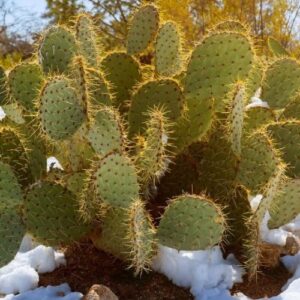
The harsh desert environment of Phoenix can take a toll on even the most resilient trees. With scorching sun, limited water, and dry winds, these conditions can push trees into a state of distress.
Many planned communities have specific lists of desert-adapted trees residents can plant. Those trees help make our neighborhoods feel less like barren landscapes and more like established communities with a touch of desert charm.
By learning the signs of stressed trees, we can take action to help them thrive.
Key Takeaways:
- Phoenix's desert climate can stress even the toughest of trees.
- Don’t ignore signs of tree stress.
- With proper care, you can keep your Phoenix trees healthy and thriving in your neighborhood.
Common Causes of Tree Stress in Phoenix
From the fragrant blooms of the Desert Willow to the iconic silhouette of the Palo Verde, Phoenix’s well-adapted trees add a touch of beauty to our neighborhoods all year round. However, there are many reasons they can become stressed in the desert, including:
- Improper Plant Selection: Choosing plants not well-suited for the desert climate. Some plants require more moisture or shade than the desert environment provides.
- Improper Plant Location: Placing a plant in an area with too much sun exposure or reflected heat can cause stress and damage.
- Improper Fertilization: Over-fertilizing or using the wrong type of fertilizer can also stress trees.
- Drought: Prolonged periods of low rainfall are common in Phoenix. A lack of adequate irrigation can put significant stress on trees.
- Extreme Heat: Those long summer days of intense heat can overwhelm a tree’s ability to regulate its temperature and water loss through transpiration.
- Pests and Diseases: Trees suffering from environmental factors are more vulnerable to pest infestations and diseases.
- Soil Compaction: Soil compaction from foot traffic, construction, or improper landscaping can limit a tree’s ability to absorb water and nutrients, adding to its stress.
6 Signs of Tree Stress
Now that we understand some common culprits behind stressed trees, let's examine the specific signs to watch out for.
Wilting or Drooping Leaves
Leaves should be firm and have a healthy sheen. When they become limp and lose their structure, this usually indicates underwatering, especially during the hot summer months. Just like your skin, tree leaves can also become sunburned. If wilting is accompanied by leaves changing colors, or if this occurs on a recently planted tree, it might be a sign of improper placement in an area with too much sun exposure.

Watch for tree leaves that are changing color or dropping prematurely.
Leaf Discoloration
Underwatering, nutrient deficiencies from proper fertilization, or extreme heat can cause yellowing or browning of the leaves. If you notice this is concentrated on only specific branches rather than throughout the whole tree, it could be a sign of disease or pest infestation in that particular area.
Premature Leaf Drop
Deciduous trees shed their leaves seasonally. However, if your tree starts dropping leaves unexpectedly when it should be holding onto them, it could be a sign of stress from drought, extreme heat, or root issues.
Some trees drop their leaves during a drought to preserve resources. But it's worth investigating further if the drop seems excessive or unusual.
Lack of New Growth
If a tree isn't producing healthy new shoots and foliage, it signifies significant stress. Prolonged droughts or improper watering can cause stress to the trees in the Phoenix area. Trees need consistent moisture, and that's hard to get from Mother Nature all of the time.
Lack of new growth can also be attributed to pests or disease damage, extreme heat, or even nutrient deficiencies. So, if you notice your tree hasn't hit a growth spurt for a while or, in severe cases, have recently noticed whole sections of the tree progressively dying from the tips of the branches inwards, it's essential to act fast.

Sunscald damage to a young tree. Image courtesy of Joseph OBrien, USDA Forest Service, Bugwood.org
Cracked or Missing Bark
Tree bark that is cracked or missing could be caused by numerous things. For example, sunscald occurs when the bark is exposed to intense sunlight for prolonged periods. If young or thin bark is exposed to too much direct sunlight, it can dry out and crack.
In addition to sunscald and other heat-related issues, mechanical damage from lawn equipment or infestations from insects like bark beetles can also weaken and injure the bark, causing it to crack and peel.
 Oozing Sap
Oozing Sap
Trees naturally produce sap to seal wounds, which are most often caused by pruning, mechanical damage, or even minor cracks. As the wound heals, the sap flow should eventually stop.
However, if your tree is already stressed by hot weather, sap flow can become excessive. High temperatures can thin the sap, making it flow more readily from wounds or insect activity.
How to Care for Stressed Trees – Call Titan, Your Phoenix, AZ Tree Care Experts
Early prevention is key! Now that you know the common signs of stressed trees (and why trees might become stressed), you can help protect Phoenix's desert oasis.
One of our tree care professionals on staff can assess the situation, diagnose the cause of the stress, and recommend a personalized treatment plan to help your tree recover and thrive.
So, if you come across a stressed tree, don’t hesitate to call Titan Tree Care at 623-444-8448 or request a free estimate on our website.
See Our Latest Articles
More Articles Like This

Titan Tree Care is a full-service tree care company located in Anthem, AZ and serving all of North Phoenix. We offer a wide range of services to meet your tree care needs, including tree and palm trimming, tree pruning, tree removal, stump grinding, and more. We also offer insect or disease treatments and fertilization services. We are dedicated to providing high-quality, safe, and effective tree care services to our customers and work hard to ensure that your trees are healthy and look their best.









